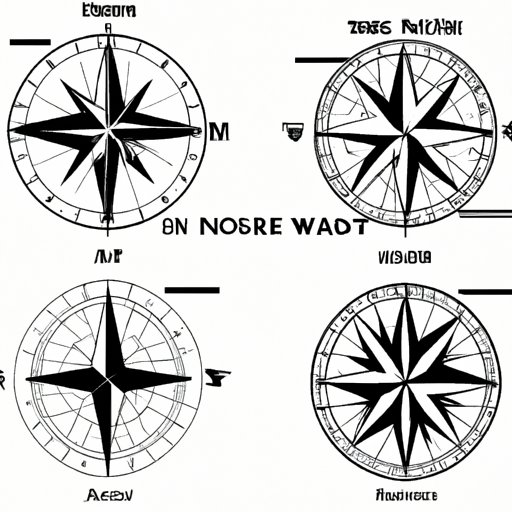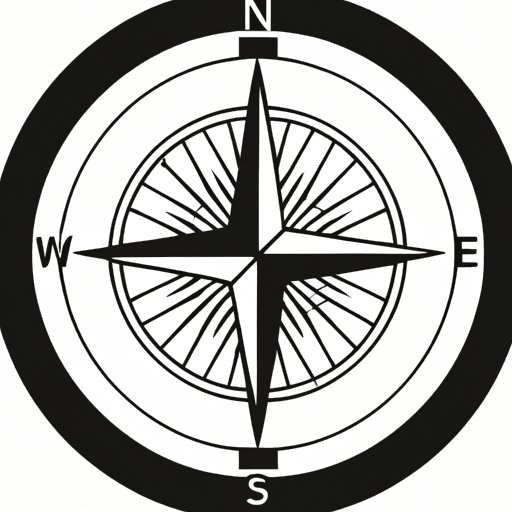Introduction
Lost in the woods or on the open sea without any guidance often leads to disaster. Using a compass rose can help you navigate accurately in such situations. This article will explain the purpose and components of a compass rose, the history behind its development, the symbolism associated with it, and its usage in modern navigation and mapmaking.
Navigating with Ease: Understanding the Purpose and Components of a Compass Rose
A compass rose is a figure used on maps and nautical charts to show directions and bearings. It serves as a navigational aid that helps sailors, aviators, and hikers orient themselves and chart their course. The compass rose’s purpose is to show North, South, East, and West and the intermediate cardinal and ordinal directions.
The components of the compass rose usually include the rose, the lines of orientation, and the directional indicators. The interior of the rose typically features directional information, such as North, South, East, West, and their corresponding variations.
Finding Your Way: The Importance and History of the Compass Rose
The compass rose has seen significant use in navigation throughout history, from early explorations to contemporary transatlantic flights. Sailors and navigators depended on the compass rose to guide their journeys across the world’s seas, oceans, and waterways, often traveling long distances in search of new land, resources, and trading opportunities.
Ancient explorers also used compass roses to navigate the world’s networks of trade and commerce. History records some of the most influential navigators who used compasses in their voyages, including Vasco da Gama, Christopher Columbus, and Zheng He, to name a few.
The Symbolism and Meaning Behind the Compass Rose
The compass rose features several symbols and meanings that have different historical, cultural, and religious backgrounds. One symbolic interpretation of the compass rose is that it represents the perfect unity of the four elements- earth, air, fire, and water. Other interpretations attribute the compass rose to navigational purposes rather than religious or philosophical symbolism.
The north symbolizes the earth’s anchor point, bringing stability and security, while the east symbolizes hope and new beginnings. The south represents warmth and passion, while the west symbolizes death and the end of things. These symbols have changed over time and blended with different cultures, resulting in many variations of the compass rose.
Using a Compass Rose to Navigate: A Beginner’s Guide
Using a compass rose is easy, but it takes some practice and knowledge to use it effectively. First, find North on your compass rose and align it with North on the map. Then, rotate the map and use the directional indicators to select a direction and follow it. Make sure to take note of landmarks and regular checkpoints to ensure that you stay on track.
If you are using a physical compass, make sure to hold it steady and level, and keep it away from any magnetic interference. You can also use a digital compass that will provide you with additional features and information like angle measurements and distance calculations.
From Ancient Times to Modern Navigation: The Evolution of the Compass Rose
The compass rose has gone through many developments and evolutions throughout history, leading to the creation of modern navigational tools and technologies. Innovations like the gyrocompass, magnetic compasses, and GPS have improved the accuracy and efficiency of navigation, making it possible to traverse the globe accurately. The future potential of the compass rose as a navigational tool is still promising, and with innovations in technology, it’s only going to get better.

The Different Types of Compass Roses and Their Uses
There are various types of compass roses, each with its distinctive features and uses. For example, the Mariner’s Compass has 32 points, representing the 32 winds that sailors encounter on the high seas. The Wind Rose compass shows the frequency, speed, and direction of winds in a particular area. The Rose Compass features a circular pattern of petals, each with an image of a cardinal direction.
Each type of compass rose has its own advantages and disadvantages, making them useful in different contexts and situations.
Exploring Cartography: Understanding the Role of the Compass Rose in Mapmaking
Cartography is the art of mapmaking, and the compass rose plays a crucial role in producing accurate maps. The compass rose aids mapmakers in establishing the orientation of a map and ensures that its symbols and features are correctly positioned. Additionally, the compass rose allows mapmakers to create maps that are relatively uniform in style and design, which helps to make them more accessible to users.
Conclusion
The compass rose is an essential tool used in navigation and mapmaking. It has a rich history and symbolism associated with it that emphasizes its importance in human history. Whether you’re a hiker, sailor, or explorer, learning how to use a compass rose is a valuable skill that can make your endeavors safer and more successful.
So next time you’re heading outdoors or looking for directions, consider using a compass rose and retire from the hassle of modern navigation technologies.
